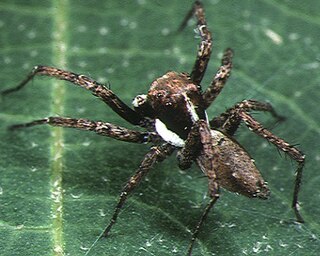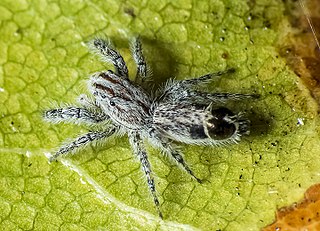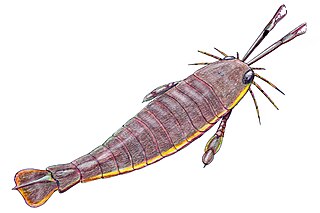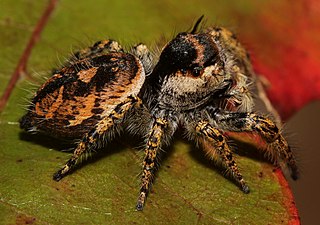
Jumping spiders or the Salticidae are a family of spiders. As of 2019, it contained over 600 described genera and over 6000 described species, making it the largest family of spiders at 13% of all species. Jumping spiders have some of the best vision among arthropods and use it in courtship, hunting, and navigation. Although they normally move unobtrusively and fairly slowly, most species are capable of very agile jumps, notably when hunting, but sometimes in response to sudden threats or crossing long gaps. Both their book lungs and tracheal system are well-developed, and they use both systems. Jumping spiders are generally recognized by their eye pattern. All jumping spiders have four pairs of eyes, with the anterior median pair being particularly large.

Portia is a genus of jumping spider that feeds on other spiders. They are remarkable for their intelligent hunting behaviour, which suggests that they are capable of learning and problem solving, traits normally attributed to much larger animals.

Spider taxonomy is that part of taxonomy that is concerned with the science of naming, defining and classifying all spiders, members of the Araneae order of the arthropod class Arachnida with about 46,000 described species. However, there are likely many species that have escaped the human eye to this day, and many specimens stored in collections waiting to be described and classified. It is estimated that only one third to one half of the total number of existing species have been described.

Abracadabrella is a genus of spiders in the family Salticidae whose spp. appear to mimics flies. The type species for the genus was described by Ludwig Koch (1879) as Marptusa elegans, transferred to Ocrisiona by Eugène Simon (1901) then placed into Abracadabrella by Marek Żabka (1991).

Afraflacilla is a genus of the spider family Salticidae. Most species are distributed in Eastern to Northern Africa and Australia, with one species found in Europe. This genus was for a time included in the genus Pseudicius, and the boundaries between both genera are disputed. In 2016 Jerzy Prószyński erected the genus Psenuc for some borderline species. The name Afraflacilla is combined from Africa, where most earlier described species were found, and FlacillaSimon, 1901, an obsolete salticid genus now called FlacillulaStrand, 1932. This genus name is in turn derived from Aelia Flaccilla, wife of Roman Emperor Theodosius I. Afraflacilla, Pseudicius, Festucula and Marchena are close relatives and form a monophyletic group.

Myrmaplata plataleoides, also called the Kerengga ant-like jumper, is a jumping spider that mimics the Kerengga or weaver ant in morphology and behaviour. This species is found in India, Sri Lanka, China and many parts of Southeast Asia.

Stylonurus is a genus of prehistoric eurypterid of the family Stylonuridae. The genus contains three species: Stylonurus powriensis from the Devonian of Scotland, Stylonurus shaffneri from the Devonian of Pennsylvania and Stylonurus perspicillum from the Devonian of Germany.
Woodwardopterus is a genus of prehistoric eurypterid classified as part of the family Mycteroptidae. The genus contains one species, W. scabrosus, from the Carboniferous of Glencartholm, Scotland.

Spiders are air-breathing arthropods that have eight legs, chelicerae with fangs generally able to inject venom, and spinnerets that extrude silk. They are the largest order of arachnids and rank seventh in total species diversity among all orders of organisms. Spiders are found worldwide on every continent except for Antarctica, and have become established in nearly every habitat with the exceptions of air and sea colonization. As of July 2019, at least 48,200 spider species, and 120 families have been recorded by taxonomists. However, there has been dissension within the scientific community as to how all these families should be classified, as evidenced by the over 20 different classifications that have been proposed since 1900.

Eurypteroidea are an extinct superfamily of eurypterids. It contains three families and two genera of uncertain classification, Paraeurypterus and Pentlandopterus.
Attinella dorsata is a species of spider from the family Salticidae.

Abracadabrella elegans is a species of jumping spider in the genus Abracadabrella. Its common name is Elegant Fly Mimic. It is reasonably common in coastal Eastern Australia, mostly Queensland. It appears to mimic a large fly with two black raised, rounded mounds on the rear of the abdomen, which look like eyes, and its spinnerets which resemble a fly's mouthparts. It walks backwards apparently to enhance the mimicry. Abracadabrella spp. are found on or under bark or on foliage from coastal north Queensland south to at least the central coast NSW.
Myrmage dishani is a species of spiders of the genus Myrmage. It is endemic to Sri Lanka. The species was first found from Eastern part of Sinharaja Forest Reserve. The species can easily identified by the round opisthosoma, without any visible, constrict. However, the species is much similar to Myrmage imbellissyn.: Myrmarachne imbellis.

Diploperculata is an infraorder of eurypterids, an extinct group of aquatic arthropods commonly known as "sea scorpions". The name, derived from Greek διπλόω ("double") and operculum, refers to the distinguishing feature that unites the superfamilies included in the group, that the genital operculum is made up of two fused segments.

Onychopterellidae are an extinct family of eurypterids. The family is the only family classified as part of the superfamily Onychopterelloidea. Genera included are Alkenopterus, Onychopterella and Tylopterella.

Moselopteridae are an extinct family of eurypterids. It is the only family classified as part of the superfamily Moselopteroidea, and contains three genera: Moselopterus, Stoermeropterus and Vinetopterus.

Phidippus arizonensis is a spider in the family Salticidae, in the infraorder Araneomorphae . The distribution range of Phidippus arizonensis includes the United States and Mexico.
Phidippus comatus is a species of jumping spider in the family Salticidae. It is found in North America.

Hentzia mitrata, the white-jawed jumping spider, is a species of jumping spider in the family Salticidae. It is found in the United States, Canada, and Bahama Islands.
Saphrys tehuelche is a species of jumping spider. The species was classified in the genus Euophrys from its first description by María Elena Galiano in 1968 until 2015. It can be found in Chile.















